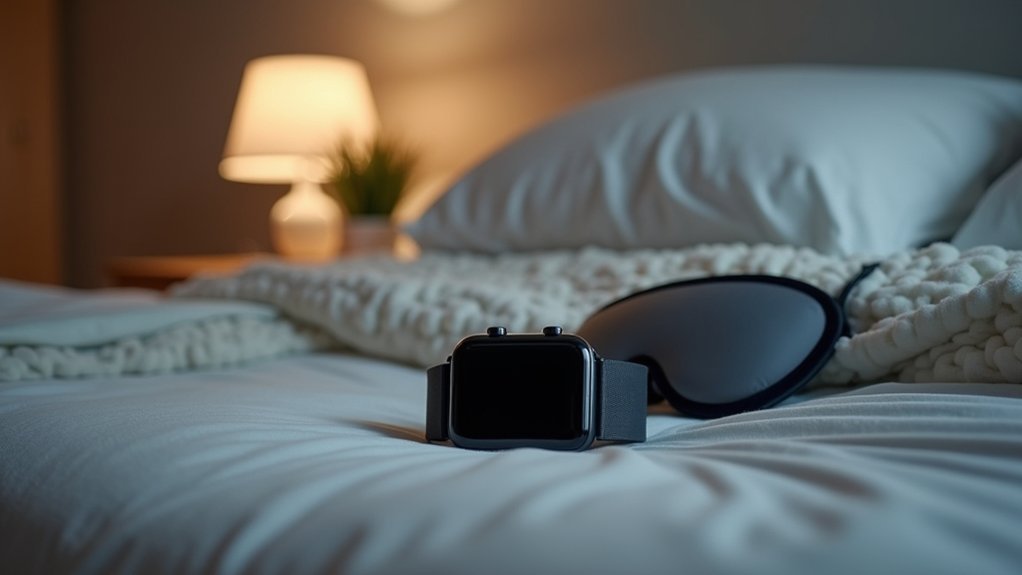To maximize your auto-detection tracker’s effectiveness, start by optimizing your sleep environment with blackout curtains and maintaining bedroom temperature between 60-68°F for better detection accuracy. Next, calibrate your movement sensitivity settings based on how rested you feel—increase sensitivity if you’re exhausted despite adequate sleep hours, or keep default settings if you wake up refreshed. Finally, maintain consistent device placement on the same wrist location each night, ensuring it’s snug but comfortable. These foundational steps will reveal deeper insights into your sleep patterns.
Optimize Your Sleep Environment for Better Detection Accuracy

Since auto-detection trackers rely heavily on environmental cues and physiological signals to monitor your sleep patterns accurately, creating an ideal sleep environment becomes essential for reliable data collection.
Control ambient light exposure by using blackout curtains or eye masks, as excess artificial light suppresses melatonin and disrupts your circadian rhythms.
Darkness triggers natural melatonin production, making blackout curtains and eye masks essential tools for maintaining healthy sleep-wake cycles.
Maintain your bedroom temperature between 60-68°F to facilitate faster sleep onset and prevent frequent awakenings that mislead motion-based detection.
Minimize noise pollution with white noise machines or soundproofing to reduce sleep fragmentation.
Establish consistent sleep environment settings by avoiding bed partners, pets, or adjustable surfaces that introduce false movement readings.
Limit exposure to air pollutants using purifiers and hypoallergenic bedding for uninterrupted sleep. Remember that sleep trackers estimate sleep based on measured inactivity rather than providing direct measurement of your actual sleep stages.
Calibrate Movement Sensitivity Settings Based on Your Sleep Patterns
While most auto-detection trackers come with default movement sensitivity settings, you’ll need to customize these thresholds to match your unique sleep patterns for accurate data collection. If you’re waking up tired despite showing adequate sleep hours, increase sensitivity to detect subtle movements indicating restless periods. Conversely, if you experience minimal sleep disruption, normal settings typically work well.
| Sleep Issue | Recommended Sensitivity |
|---|---|
| Feel exhausted despite 8+ hours | High sensitivity |
| Frequent unexplained fatigue | Increase gradually |
| Partner complains about tossing | Medium-high sensitivity |
| Wake feeling refreshed | Normal/default settings |
| Minimal sleep complaints | Low-normal sensitivity |
Experiment with incremental adjustments while reviewing your sleep reports weekly. Manual sleep mode activation can provide ground truth data for better calibration accuracy. Remember that data interpretation varies widely among individuals, so prioritize how you actually feel over what the metrics suggest.
Maintain Consistent Wearing Position and Device Placement

After optimizing your tracker’s sensitivity settings, proper device placement becomes the foundation for collecting reliable sleep data.
You’ll want to position your tracker consistently on the same wrist location each night, as repositioning affects measurement accuracy and creates signal variability. Choose a comfortable spot that won’t cause pressure points or muscle strain during sleep, since discomfort leads to unconscious removal or shifting.
Make certain your device sits snugly against your skin without being too tight. Loose placement creates motion artifacts and signal loss, while overly tight bands cause circulation issues.
Proper tracker fit balances snugness for accurate readings with comfort to prevent circulation problems and signal interference.
Follow your manufacturer’s placement guidelines exactly, and consider using visual markers to maintain the same position. This consistency eliminates data gaps and makes sure your sleep patterns remain accurately tracked over time. Proper fitting increases user satisfaction and ensures better device compliance with your health monitoring routine.
Frequently Asked Questions
How Often Should I Clean My Auto-Detection Tracker for Optimal Performance?
You should clean your auto-detection tracker every 3-6 months under normal conditions. If you’re driving in dusty or harsh environments, increase cleaning frequency to maintain sensor accuracy and prevent performance issues.
What Battery Life Can I Expect From My Sleep Tracking Device?
You can expect battery life ranging from several days to two weeks, depending on your device. Oura Ring 4 lasts eight days, while Ringconn claims ten to twelve days with typical usage.
Can Medications or Health Conditions Affect My Tracker’s Detection Accuracy?
Yes, medications can alter your heart rate and exercise responses, affecting tracker accuracy. Health conditions like cardiovascular issues also impact detection reliability. You should consult your doctor about potential medication interactions.
Should I Wear My Tracker on My Dominant or Non-Dominant Wrist?
You can wear your tracker on either wrist, but choose consistently. Your non-dominant wrist often provides more accurate step counts since it experiences less interfering movement during daily tasks.
How Long Does It Take for the Device to Learn My Patterns?
Your device typically learns basic patterns within 1-2 weeks of consistent wear. However, it’ll continue improving accuracy for several months as it accumulates more data about your unique behaviors and activities.
In Summary
You’ll maximize your auto-detection tracker’s effectiveness by creating an ideal sleep environment, fine-tuning sensitivity settings to match your unique patterns, and maintaining consistent device placement. Don’t expect perfect results overnight—it takes time to find your best configuration. Stay patient as you adjust these settings, and you’ll soon enjoy more accurate sleep tracking data that truly reflects your nightly rest patterns and helps improve your overall sleep quality.





Leave a Reply